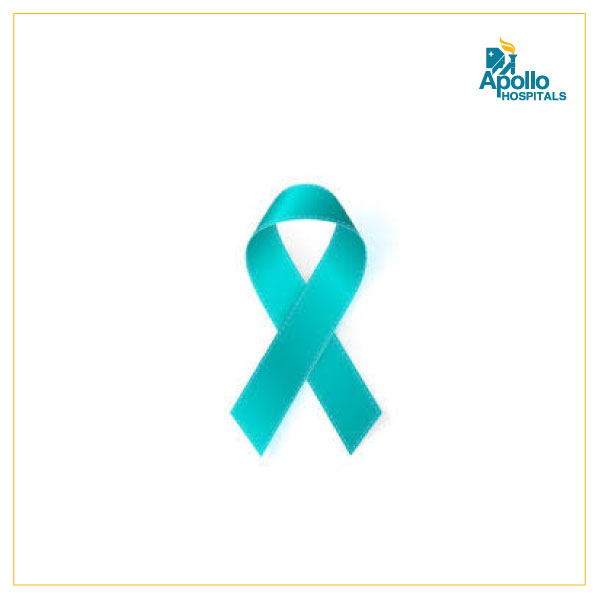Ovarian cancer – Frequently Asked Questions II
- 1021 Views
- Apollo Hospital Mumbai
- December 28, 2020
- Uncategorized
Ovarian cancer – Frequently Asked Questions II

Who is at high risk for ovarian cancer?
Age
Older women have a higher risk for ovarian cancer than younger women. Ovarian cancer usually occurs after menopause, although it can develop in women of all ages. Most women diagnosed with ovarian cancer are older than age 55.
Family History
Women are at high risk for ovarian cancer and for harboring a genetic mutation such as BRCA if they have a:
- First-degree relative (mother, sister, or daughter) with ovarian cancer at any age. The risk increases with the number of affected first-degree relatives.
- First-degree relative or two second-degree relatives (aunts or grandmothers) on the same side who had breast cancer before age 50 years.
- Family member with both breast and ovarian cancer.
- Family history of male breast cancer.
- Family history of hereditary non-polyposis colorectal cancer known as Lynch syndrome.
When a woman describes her family history to her doctor, she should include the history of cancer in women on both the mother’s and the father’s side. Both are significant.
Genetic Mutations
Inherited mutations in the genes called BRCA1 and BRCA2 greatly increase the risk for ovarian and breast cancers. While these mutations are more common among women of Ashkenazi Jewish ancestry, they can occur in women of any ethnicity.
Women with a BRCA1 mutation have about a 44% lifetime risk for ovarian cancer. Women with a BRCA2 mutation have about a 17% lifetime risk for ovarian cancer. (By contrast, the lifetime ovarian cancer risk for women in the general public is about 1 in 55 or 1.3%.)
These gene mutations are also associated with increased risks for breast cancer, fallopian tube cancer, pancreatic cancer, and prostate cancer in the male.
In addition to an increased lifetime risk, women with these gene mutations tend to develop these cancers at an earlier age than that seen in the usual population of women with ovarian cancer.
Other genetic factors are also associated with increased risk. Women who have genetic mutations associated with hereditary non-polyposis colorectal cancer (HNPCC or Lynch syndrome) have about a 10% to 15% lifetime risk of developing ovarian cancer.
Personal Medical History
Women who have been diagnosed with breast cancer are at increased risk for ovarian cancer, even if they do not have BRCA mutations.
Endometriosis, a condition in which the cells that line the cavity of the uterus grow in other areas of the body such as on the ovaries or on the other pelvic structures, increases the risk for ovarian cancer.
Reproductive History
Women are at increased risk for ovarian cancer if they began menstruating at an early age (before age 12), have not had any children, had their first child after age 35, or experienced early menopause (before age 50).
There are also preventive factors associated with reproductive history. The more times a woman gives birth, the less likely she is to develop ovarian cancer. Breast-feeding for a year or more after giving birth may also decrease ovarian cancer risk.
Tubal ligation, a method of sterilization that ties off the fallopian tubes, is associated with a decreased risk for ovarian cancer. Similarly, hysterectomy, the surgical removal of the uterus, may decrease risk.
Hormone Use
Women who use hormone therapy (HT) after menopause for longer than 5 years may have an increased risk for ovarian cancer. The risk seems to be particularly significant for women who take estrogen-only HT. The risk is less clear for combination estrogen-progestin HT.
Oral contraceptives (birth control pills) significantly reduce the risk of ovarian cancer, in some series by as much as 50%. The longer a woman takes oral contraceptives the greater the protection and the longer protection lasts after stopping oral contraceptives.
Obesity
Women who are obese have an increased risk for ovarian cancer.
What are the chances I have ovarian cancer?
The lifetime risk of ovarian cancer for women in the general public is about 1 in 55 or 1.3%.
Common Symptoms of Ovarian Cancer
Ovarian cancer does have symptoms, but they are often very subtle and easily mistaken for other, more common problems. In some rare cases, early stage ovarian cancers may produce symptoms, but in the majority of women these don’t show up until the cancer has advanced (when the growth of the tumor triggers symptoms). Several studies show that ovarian cancer can produce these symptoms:
- Bloating
- Pelvic or abdominal pain
- Difficulty eating or feeling full quickly
- Urinary symptoms like urgency (always feeling like you have to go ) or frequency (having to go often)
If you have these symptoms for more than two weeks, and the symptoms are new or unusual for you, see a Gynec Oncologist and ask about Ovarian Cancer.
Diagnosis of Ovarian Cancer
If a woman has the signs and symptoms of ovarian cancer, she needs a complete pelvic exam by a GynecOncosurgeon, a CT scan or MRI scan, and a CA-125 blood test.
The most important factors to be considered are the patient’s age, menopausal status, family history of any malignancy, clinical examination, and the results of blood levels of tumor markers i.e. CA-125 and imaging studies like CT or MRI scan.
Because of the lethality of ovarian cancer, it is considered advisable to “err on the side of caution.”
American College of Obstetrics and Gynecology (ACOG) and SGO consensus guidelines recommend referral to a gynecologic oncologist for women with elevated blood level of CA-125, presence of fluid in abdomen, an ovarian mass and evidence of abdominal/distant metastasis.
At what age ovarian cancer occurs?
The risk of developing ovarian cancer gets higher with age. Ovarian cancer is rare in women younger than 40. Most ovarian cancers develop after menopause. Ovarian cancer can occur at any age but is most common in women ages 50 to 60 years.
How ovarian cancer is diagnosed?
If a woman has the signs and symptoms which suggest possibility of ovarian cancer, she needs a complete pelvic exam by a GynecOncosurgeon, a CT scan or MRI scan, and a CA-125 blood test.
The most important factors to be considered to know a woman’s risk of ovarian cancer are, the patient’s age, menopausal status, family history of any malignancy, clinical examination, and the results of blood levels of tumor markers i.e. CA-125 and imaging studies like CT or MRI scan.
Because of the lethality of ovarian cancer, it is considered advisable to “err on the side of caution.”
If there is a suspicion from these tests that ovarian cancer might be present, the patient should seek a referral to a gynecologic oncologist for Cytoreductive surgery and further treatment. Research shows that women treated by gynecologic oncologists live longer than those treated by other physicians like general gynaecologists and general surgeons.
American College of Obstetrics and Gynecology (ACOG) and SGO consensus guidelines recommend referral to a gynecologic oncologist for women with elevated blood level of CA-125, presence of fluid in abdomen, an ovarian mass and evidence of abdominal/distant metastasis.
Treatment options of ovarian cancer
The standard treatment for ovarian cancer consists of debulking surgery followed by six cycles of chemotherapy.
The most important prognostic factors predicting long-term survival from ovarian cancer are the FIGO stage and theamount of disease remaining after debulking surgery. Patients with ovarian cancer will benefit from treatment by agynecologic oncologist or physicians familiar with the disease and skilled in its surgical management.
Patients undergo chemotherapy in an effort to kill any cancer cells that remain in the body after surgery.
A gynecologic oncologist is a specialist in treating women’s reproductive cancers. Women with ovarian cancer are strongly encouraged to seek care from one of these specialists.
Multiple studies conducted over the past decade have shown that an ovarian cancer patient’s chance of survival is significantly improved when her surgery is performed by a gynecologic oncologist. One analysis of multiple studies found that women whose surgeries were performed by gynecologic oncologists had a median survival time that was 50 percent greater than women whose surgeries were done by general gynecologists or other surgeons inexperienced in optimal debulking procedures.
Sometimes referred to as cytoreductive surgery, debulking involves removal of as much of the tumor as possible.
Women whose tumors have been reduced to less than one centimeter have a better response to chemotherapy and improved survival rate.
Prevention of ovarian cancer
Most women have one or more risk factors for ovarian cancer. There are several ways to reduce one’s risk of developing ovarian cancer.
Some risk factors for ovarian cancer, like getting older or having a family history, cannot be changed. But women might be able to lower their risk slightly by avoiding other risk factors, for example, by staying at a healthy weight, or not taking hormone replacement therapy after menopause.
Oral contraceptives
Using oral contraceptives (birth control pills) decreases the risk of developing ovarian cancer for average risk women and BRCA mutation carriers , especially among women who use them for several years. Women who used oral contraceptives for 5 or more years have about a 50% lower risk of developing ovarian cancer compared with women who never used oral contraceptives. Still, birth control pills do have some serious risks and side effects such as slightly increasing breast cancer risk. Women considering taking these drugs for any reason should first discuss the possible risks and benefits with their doctor.
Gynecologic surgery
Both tubal ligation and hysterectomy may reduce the chance of developing certain types of ovarian cancer, but experts agree that these operations should only be done for valid medical reasons — not for their effect on ovarian cancer risk.
Prevention strategies for women with a family history of ovarian cancer or BRCA mutation
Oral contraceptives is one way that high risk women (women with BRCA1 and BRCA2 mutations) can reduce their risk of developing ovarian cancer.
Risk-reducing or prophylacticsalpingo-oophorectomy (removal of both ovaries and fallopian tubes) is the standard recommendation for high-risk women after they have finished having children.
What foods prevent ovarian cancer?
The risk of ovarian cancer decreases by maintaining a weekly exercise regime and a healthy diet. By working out 30 minutes every day, you can decrease your risk by up to 20%. Along with an active lifestyle, incorporating certain foods into your diet can also decrease your risk. Foods like beans, eggs, nuts, and other foods that provide Vitamin D are recommended as well as foods high in Vitamin A like carrots, leafy greens, and sweet potatoes.
- January 20, 2025
Total Knee Replacement: The Role of Robotics
- January 20, 2025
Awareness and Precautions Against Human Metapneumovirus (HMPV)
- January 20, 2025
Aortic Root Replacement
- December 26, 2024
Robotic Surgery in Orthopedics
- Bone Marrow Transplant3
- Cardiac sciences44
- Cardiology1
- Child Care7
- Clinical Excellence33
- Cosmetology2
- COVID-199
- Diseases4
- Emergency10
- Emergency8
- Endocrinology1
- ENT5
- Fetal Medicine1
- Gastroenterology8
- General Medicine11
- General Surgery4
- Genomic Medicine2
- Gynecology1
- Health14
- Hematology2
- Kidney Transplant5
- Kidney Transplant2
- Liver Transplant6
- Neonatology1
- Nephrology2
- Nephrology & transplant1
- Nephrology & Urology4
- Neurosciences21
- Neurosciences1
- Nutrition/Diet1
- Obstetrics & Gynecology9
- Obstetrics & Gynecology4
- Oncology3
- Oncology93
- Ophthalmology1
- Orthopedic15
- Patient Speak1
- Pediatric Surgery4
- physiotherapy2
- Psychologist2
- Pulmonology4
- Rheumatology1
- Robotic Suregry1
- Robotic Surgery11
- Spine1
- Uncategorized111
- Urology1
- Women Care5
